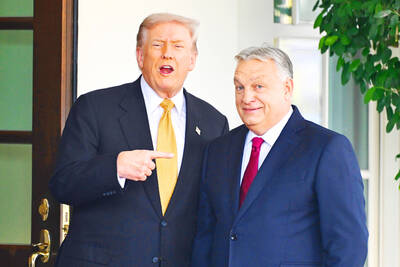An Indian rocket launched a record 10 satellites into orbit in a single mission yesterday, underlining the nation’s emergence as a major competitor in the multibillion-dollar space market.
The Polar Satellite Launch Vehicle (PSLV) rocket ejected all the satellites within minutes of each other after liftoff at 9:20am in clear weather from the Sriharikota space station in southern India, the Indian Space Research Organization (ISRO) said.
The PSLV first put into polar orbit the remote-sensing Indian satellite, Cartosat-2A, fitted with a high-resolution camera and advanced scientific instruments.
It also launched an 83kg Indian mini-satellite and a cluster of eight so-called nano-satellites, each weighing between 3kg and 16kg, built by research institutions from Europe, Canada and Japan.
The PSLV, the workhorse of India’s space program, blasted off on its 13th flight leaving behind a massive trail of orange and white smoke.
“The mission was perfect,” said G. Madhavan Nair, chairman of the Bangalore-based ISRO, after the launch was telecast live by public broadcaster Doordarshan.
“It is a historic moment for us because it is the first time that we have launched 10 satellites in a single mission,” he said, congratulating Indian scientists who broke into applause at the mission control center.
The flight, which Nair said had not deviated “even a dot” from its specifications, broke the previous record of eight satellites launched at one go by a Russian rocket, according to Indian newspaper reports.
The marketing arm of ISRO, Antrix Corporation, charged a fee for the launch of the miniature foreign satellites.
India, which launched its space program 45 years ago, wants to compete alongside the US, Russia, China, the Ukraine and the European Space Agency in offering commercial satellite launch services.
“By launching so many satellites at one go, India has showcased the commercial applicability of its space program,” said Ajay Lele, a space expert at the Institute of Defense Studies and Analyses in New Delhi.
“It wants to market its launch systems and also its capability in earth imagery,” Lele said. “The mission is very significant from a commercial point of view.”
India first staked its case for a share of the commercial launch market by sending an Italian spacecraft into orbit in April last year. In January, it launched an Israeli spy satellite despite Iranian protests.
India carried out the first successful launch of a domestic satellite by a home-built rocket in 1980, when it was less preoccupied with reaping commercial benefits and more with harnessing space technology to boost deficient communications and broadcasting facilities.
Cartosat-2A, the main satellite launched yesterday to an altitude of 630km above earth, also has a domestic economic dimension and can be used for intelligence gathering as well, officials say.
More advanced than a predecessor launched in January last year, it will boost India’s efforts to reinforce urban and rural infrastructure to keep pace with economic growth that averaged nearly 9 percent in the past four years.
The satellite will beam “clear and detailed images of even miniscule objects” on earth, will aid economic planners in land and water resources management, Lele said.

James Watson — the Nobel laureate co-credited with the pivotal discovery of DNA’s double-helix structure, but whose career was later tainted by his repeated racist remarks — has died, his former lab said on Friday. He was 97. The eminent biologist died on Thursday in hospice care on Long Island in New York, announced the Cold Spring Harbor Laboratory, where he was based for much of his career. Watson became among the 20th century’s most storied scientists for his 1953 breakthrough discovery of the double helix with researcher partner Francis Crick. Along with Crick and Maurice Wilkins, he shared the

OUTRAGE: The former strongman was accused of corruption and responsibility for the killings of hundreds of thousands of political opponents during his time in office Indonesia yesterday awarded the title of national hero to late president Suharto, provoking outrage from rights groups who said the move was an attempt to whitewash decades of human rights abuses and corruption that took place during his 32 years in power. Suharto was a US ally during the Cold War who presided over decades of authoritarian rule, during which up to 1 million political opponents were killed, until he was toppled by protests in 1998. He was one of 10 people recognized by Indonesian President Prabowo Subianto in a televised ceremony held at the presidential palace in Jakarta to mark National

US President Donald Trump handed Hungarian Prime Minister Viktor Orban a one-year exemption from sanctions for buying Russian oil and gas after the close right-wing allies held a chummy White House meeting on Friday. Trump slapped sanctions on Moscow’s two largest oil companies last month after losing patience with Russian President Vladimir Putin over his refusal to end the nearly four-year-old invasion of Ukraine. However, while Trump has pushed other European countries to stop buying oil that he says funds Moscow’s war machine, Orban used his first trip to the White House since Trump’s return to power to push for

LANDMARK: After first meeting Trump in Riyadh in May, al-Sharaa’s visit to the White House today would be the first by a Syrian leader since the country’s independence Syrian President Ahmed al-Sharaa arrived in the US on Saturday for a landmark official visit, his country’s state news agency SANA reported, a day after Washington removed him from a terrorism blacklist. Sharaa, whose rebel forces ousted long-time former Syrian president Bashar al-Assad late last year, is due to meet US President Donald Trump at the White House today. It is the first such visit by a Syrian president since the country’s independence in 1946, according to analysts. The interim leader met Trump for the first time in Riyadh during the US president’s regional tour in May. US envoy to Syria Tom Barrack earlier